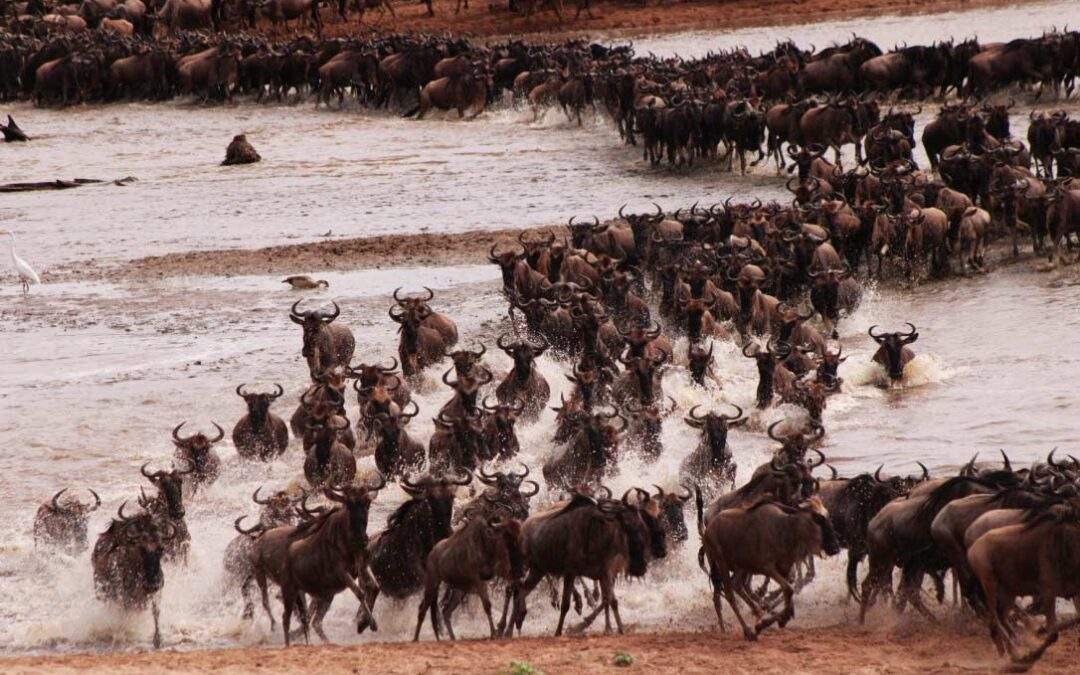The Great Wildebeest Migration
The Great Migration is an annual migration of millions of wildebeests into Tanzania. The spectacle has repeated for thousands of years and is the largest annual movement of animals anywhere on earth. Serengeti National Park is the world-famous site of this yearly phenomenon, where herds of wildebeests, zebras, antelope, and more make the dangerous trek.
The Great Migration showcases nature in its most raw form: as herds of animals move across the plains of Africa, through dangerous rivers and over beautiful landscapes, you will be enraptured by Africa.
It is worth noting that the Great Migration in the Serengeti National Park takes place all year in some form. Due to its massive size, it is possible to meet herds of wildebeests in different parts of the park.
Migration seasons of antelopes
November – January
The migration cycle of Serengeti National Park begins in this period when animals move from Kenya’s Maasai Mara National Reserve to the southeast part of the Serengeti. This is the dry season in Tanzania and approximately 1.7 million antelopes, accompanied by 260,000 zebras and 470,000 gazelles move to the Serengeti’s alleys covered with short grass. This time is also mating season for zebras and therefore vital to the future of these species.
February – March
In February, the migration passes through the southern part of Serengeti National Park and in the Ngorongoro Conservation Area. This period is the peak season for fertility for antelopes and is important for the formation of the next generation. New antelopes are born during this season, and visitors may see the young walking with the herd, protected from predators and able to run at an incredible speed at only a few days old.
By early March the fodder near the Ngorongoro disappears and antelopes have to migrate to the western part of the Serengeti, to the region of the Grumeti River.
April
The big herds of animals move to the central part of the park named Seronera. This period is the rainy season in Tanzania. Heavy and prolonged rainfalls give animals tens of thousands of square kilometers of fresh grass for their nutrition.
May – June
This is the end of the rainy season. Herds of antelopes continue to move to the west, to the region named Western Corridor. On their way, they must cross the Mbalageti and Grumeti rivers. National Geographic and Discovery Channel continue to organize expeditions and film the incredible Grumeti River crossing, capturing the danger of the herds charging through crocodile-infested waters. It is a truly exciting thing to watch, and seeing it all live, in person can never be matched with a television episode.
July
July is the beginning of the dry season in Tanzania. There are no rains and animals continue to move to the north, towards the border with Kenya along the Grumeti region. At the end of August, this amazing cycling of animals reaches the borders of monitoring areas of Ikorongo (where there is the famous German Fort Ikoma, described in Bernard Grzimek’s book “Serengeti shall not Die”).
August – October
At the end of September, the migration reaches the border with Kenya. In October, during the peak of the dry season, most of the animals migrated to the Maasai Mara in Kenya where there is a lot of fresh water and plenty of grass.
Tour ideas to get you dreaming
Featured Tanzania Safari Packages
Experience the best of Tanzania’s wilderness with our featured safari packages. Discover iconic national parks, encounter majestic wildlife, and immerse yourself in the beauty of the African landscape. From thrilling game drives to cultural encounters, our packages offer an unforgettable adventure. Choose your perfect safari and create lifelong memories in Tanzania.
A Glimpse of a Luxury Safari
11 Days 10 Nights
Journey into Tanzania Wild
9 Days 8 Nights
A Journey of Discovery
3 Days 2 Nights
The Treasure of Tanzania Safari
6 Days 5 Nights
Ndutu Safari Calving Season
5 Days 4 Nights
Serengeti Wildebeest Migration
10 Days 9 Nights


